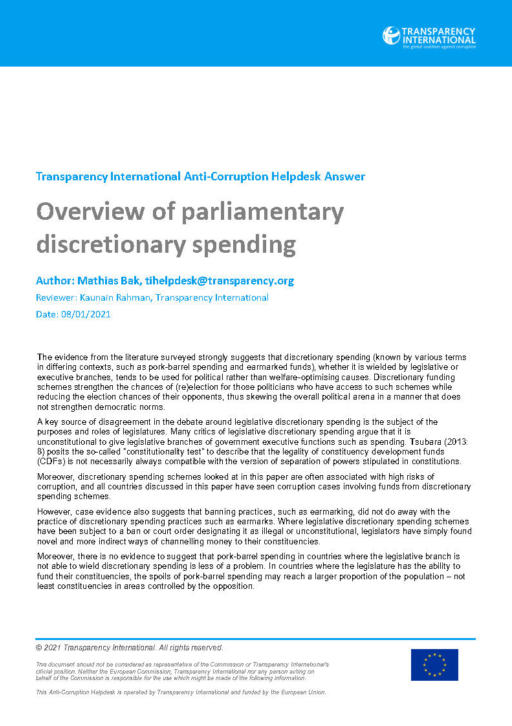
This Anti-Corruption Helpdesk brief was produced in response to a query from one of Transparency International’s national chapters. The Anti-Corruption Helpdesk is operated by Transparency International and funded by the European Union.
Query
Provide an overview of practices whereby a part of the state budget can be distributed by the parliament to organisations, public or private, according to their own wishes (usually to their regional constituents)?
Summary
The evidence from the literature surveyed strongly suggests that discretionary spending (known by various terms in differing contexts, such as pork-barrel spending and earmarked funds), whether it is wielded by legislative or executive branches, tends to be used for political rather than welfare-optimising causes. Discretionary funding schemes strengthen the chances of (re)election for those politicians who have access to such schemes while reducing the election chances of their opponents, thus skewing the overall political arena in a manner that does not strengthen democratic norms.
A key source of disagreement in the debate around legislative discretionary spending is the subject of the purposes and roles of legislatures. Many critics of legislative discretionary spending argue that it is unconstitutional to give legislative branches of government executive functions such as spending. Tsubara (2013: 8) posits the so-called “constitutionality test” to describe that the legality of constituency development funds (CDFs) is not necessarily always compatible with the version of separation of powers stipulated in constitutions. Moreover, discretionary spending schemes looked at in this paper are often associated with high risks of corruption, and all countries discussed in this paper have seen corruption cases involving funds from discretionary spending schemes.
However, case evidence also suggests that banning practices, such as earmarking, did not do away with the practice of discretionary spending practices such as earmarks. Where legislative discretionary spending schemes have been subject to a ban or court order designating it as illegal or unconstitutional, legislators have simply found novel and more indirect ways of channelling money to their constituencies. Moreover, there is no evidence to suggest that pork-barrel spending in countries where the legislative branch is not able to wield discretionary spending is less of a problem. In countries where the legislature has the ability to fund their constituencies, the spoils of pork-barrel spending may reach a larger proportion of the population – not least constituencies in areas controlled by the opposition.
Contents
1. Introduction
2. Discretionary spending in the form of earmarks and Constituency Development Funds (CDFs)
3. Case studies
4. Best practices for addressing corruption risks in legislative discretionary spending
Main points
- In many cases legislative discretionary spending has been used to strengthen incumbents’ chances of re-election, and lines between what is vote-buying and what is a public project can sometimes be blurry.
- Discretionary funds often have a high risk of corruption, such as embezzlement and favouritism, among others.
- Legislative discretionary spending has proven difficult to control and regulate, and bans have not always ended the practice.
- While there is no universally applicable solution to address governance risks in legislative discretionary funds, the space for corruption and vote-buying becomes smaller with more rigid transparency rules and implementation.
Authors
Mathias Bak, [email protected]
Reviewer
Kaunain Rahman, Transparency International
Date
25/01/2021

